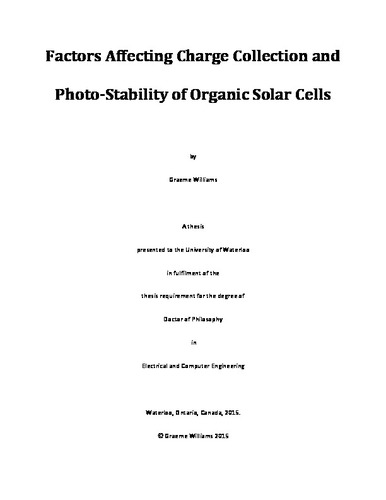| dc.description.abstract | Organic photovoltaics employ small molecules or polymers as their primary light absorbing materials and thus differ strongly from traditional silicon-based photovoltaics. Their primary technological benefit is a significant reduction in materials and module fabrication costs. While research on organic solar cells (OSCs) has increased dramatically in the past decade, both OSC efficiencies and device lifetimes must be improved before they can compete with existing second generation photovoltaic technologies. Many of the gains in OSC efficiency to date can be attributed to the vast and concurrent trial-and-error experiments on new donor materials and processing techniques to form traditional bulk heterojunction structures. The field is consequently lacking in predictive power, and many stipulations regarding ideal device architectures and optimal interfacial layers remain ambiguous. Furthermore, OSC lifetime is much less studied in literature compared to OSC efficiency, and fundamental studies identifying the primary mode of degradation observed in OSCs under standard operation are lacking. It is thus beneficial to systematically study charge transport and charge extraction in modern OSCs, especially as these phenomena vary over the lifetime of the OSC.
This thesis comprehensively examines charge collection in OSCs as a function of OSC device architecture. To maintain a coherent test platform, vacuum-deposited OSCs are fabricated with various metal phthalocyanine donor materials and a fullerene acceptor. This is in contrast to the solution-processed OSCs that have been the focus of most OSC research since 2005. By removing complications in solution coating (especially film formation and phase separation considerations), it is significantly more straightforward to study photo-physics and charge collection behaviour. In this regard, the role of interfacial layers in charge extraction is investigated, the optimal combination/proportion of neat or mixed donor and acceptor layers in terms of the photo-active materials’ properties is studied, and the impact of adding a third component to the mixed layer (i.e. ternary OSCs) is elucidated. The culmination of this work illuminates limitations in charge collection, especially in terms of the distribution of donor and acceptor material in the OSC (both in the bulk mixed layers and with regard to vertical distribution), as well as with variations made at the organic/electrode interface. The results provide guidelines to overcome device performance limitations that are pertinent for future research in both vacuum-deposited and solution-coated OSCs.
Having established a strong understanding of device performance in terms of device architecture, the variations in OSC performance and associated charge collection processes are studied as they change with time and under various stress conditions (e.g. light, heat, electrical). To this end, the most critical avenues toward hindered charge collection during the operation (light exposure) of OSCs are identified. To widen the impact and applicability of this research, a systematic study on degradation phenomena for both solution-coated polymer OSCs as well as vacuum-deposited small molecule OSCs is performed. Photo-degradation phenomena in terms of the OSC device architecture are also examined. It is shown that photo-induced degradation of the organic-electrode interface is the dominant degradation mechanism in all OSCs regardless of fabrication methodology, and that the prudent selection of interfacial layers can minimize these effects. A stronger understanding of charge collection processes in as-made and photo-degraded OSCs ultimately allows for intelligent device design to grant stable and highly efficient OSCs. | en |

